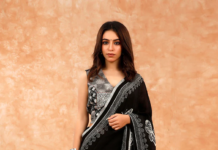Banarasi silk sarees epitomise timeless beauty, craftsmanship, and tradition. Woven with intricate designs and rich textures, women have cherished these sarees across India and beyond for centuries. This article will delve into the allure of the silk collections, such as the banarasi silk saree, exploring its history, craftsmanship, and significance in fashion.
The Legacy of Banarasi Silk Sarees
The history of the banarasi silk saree can be traced back to the ancient city of Varanasi (formerly Banaras), which has been a cradle of art, culture, and silk weaving for generations. The art of weaving these sarees has been passed down through artisan families, preserving the legacy of traditional techniques.
The Art of Weaving
Crafted from the finest silk threads, these sarees are known for their opulent brocade work. Intricate patterns and motifs inspired by nature, Mughal architecture, and folklore adorn the fabric. The weaving process is a labour of love, with skilled artisans spending weeks, sometimes months, to create a single masterpiece.
Types of Banarasi Silk Sarees
There are various Banarasi silk sarees, each with a unique charm. Some popular variants include:
Katan Silk Sarees
Katan silk sarees are woven from twisted silk yarns, creating a sturdy and luxurious fabric. They are favoured for their rich texture and are often adorned with intricate zari work.
Organza Silk Sarees
Known for their sheer elegance and lightness, organza silk sarees are perfect for formal occasions. They feature delicate patterns and are a favourite among modern brides.
Georgette Silk Sarees
Georgette silk sarees offer a blend of traditional elegance and contemporary appeal. They are lightweight and graceful drapes, making them suitable for casual and formal events.
Shattir Silk Sarees
Shattir silk sarees are characterised by their distinctive striped patterns. They are popular for their unique visual appeal and are often adorned with intricate threadwork.
Timeless Elegance for Every Occasion
Banarasi silk sarees are perfect for weddings, festivals, and special celebrations. Their grandeur and timeless charm make them a cherished possession for every Indian woman. The richness of the fabric and the mastery of craftsmanship make women specifically opt for these sarees.
The Global Influence
The allure of these sarees has transcended borders, captivating the hearts of fashion enthusiasts worldwide. Renowned designers have incorporated Banarasi motifs into their collections, putting this traditional attire on global runways.
A Tapestry of Colours
One of the captivating features is the vibrant array of colours they come in. From rich jewel tones to pastel hues, there is a Banarasi saree to suit every taste and occasion. The careful selection of colours and the interplay of shades add depth and dimension to the intricate designs, making each saree a masterpiece worth cherishing.
Zari: The Golden Thread of Tradition
A hallmark of these sarees is the lavish use of zari – a fine metallic thread, often made of gold or silver. The zari work elevates the saree’s beauty, adding a touch of opulence and grandeur. The shimmering zari patterns catch the light, creating a mesmerising effect that sets these silk sarees apart from traditional attires.
Bridal Banarasi: A Timeless Wedding Ensemble
For Indian brides, selecting a banarasi silk saree for wedding wear is a symbolic and cherished tradition. Bridal Banarasi sarees are exquisitely embellished with intricate designs, making them a symbol of auspiciousness and prosperity. Passed down as family heirlooms, these sarees carry the blessings of generations, making them a significant part of the wedding rituals.
Conclusion
Banarasi silk sarees continue to hold their timeless allure in the ever-evolving fashion world. From the skilled hands of weavers to the hearts of women across the globe, these sarees celebrate India’s rich cultural heritage and artistic legacy. So, whether you are a connoisseur of artistry or a fashion enthusiast looking for elegance, Banarasi silk sarees are a must-have addition to your wardrobe.




